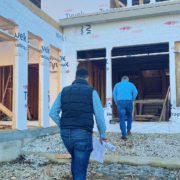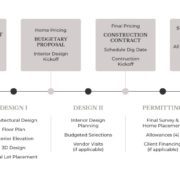10 Questions to Ask Your Potential Home Builder
When we at Miller Marriott meet with potential clients, we tell them, “We are going to be in a relationship.” And while we laugh a little when we say it, the reality is that designing and building a home is a lengthy process that requires communication, mutual respect, and trust. Homes are very personal to each client, and the process of making a vision come to life is as important as the actual end result. We encourage anyone thinking of designing and building a home to start by meeting with a prospective designer and builder, in an effort to determine if working together is truly the right combination for such an important experience.
Here are some questions we would encourage our friends and family members to ask when evaluating candidate companies to build their home.
- What differentiates you from other home builders?
Find out what the firm highlights as its ‘difference-maker.’ Is it the way the company is organized, or maybe the way it prices? The quality of its subcontractors? Perhaps it’s the company’s designs or experience? Knowing how a firm separates itself from other home builders allows you to compare your priorities for the process with the aspects on which the company focuses.What differentiates us at Miller Marriott is our people, our process, and our product. We are a true design|build company: we manage both the design phase and the construction phase of a project. Our in-house architects and interior designers share over 45 years of home design experience, and they work diligently to understand how our clients live, their lifestyles, what inspires them, and their needs. Our construction team shares over 50 years of experience, and our subcontractors and suppliers are vetted and carefully chosen. Additionally, every quality and build standard is meticulously selected to be in keeping with our timeless designs. - What does the process of designing and customizing my home look like?
Share with the firm your general vision for your home and ask the company what their process is for making it a reality. Because there are many ways to design and customize a home, it is important to discuss your specific goals. For example, do you want to build an exact floor plan you have seen but choose a new elevation and unique finishes? Or, do you have a unique piece of land and want to create something from scratch?The value that a home builder brings is in providing a path that allows you to achieve your unique goals. At Miller Marriott, we have established four distinctive approaches for creating and constructing a home. Just like the homes themselves, our methods were formed by working with clients who all had unique building needs. - How and when do you determine the cost of my home?
There are two parts to determining cost. One part is understanding what the builder—based on its minimum standards—builds for on a price-per-square-foot basis. A home builder will be able to provide rough estimates of its current average building costs based on square footage and on its build and quality standards. This can give you some general figures to start working with prior to designing.Part two is understanding how your specific home costs are determined after a design and finishes are selected. Consider asking the builder how site work gets estimated, and how vendor price increases are handled. Find out how costs may be affected by choosing to upgrade a finish, or by changing something during construction. Transparency and communication are key in keeping everyone involved on the same page; with this mindset, Miller Marriott believes in clarity on pricing and eliminating surprise costs.Most importantly: discussing your budget frankly from the start will avoid confusion—and potential heartbreak—further down the road. Sharing your budget with a potential home builder, whether your “all-in” budget (which includes the land, site work, the home, and landscaping/driveway) or your budget for the home only, is essential to determining if you and the firm are a good fit. - How do you determine price per square foot when estimating costs? What are your build and quality standards?When given an estimate on the average price-per-square-foot of a home you are considering building, it is based on certain materials, finishes, mechanicals, and other details. You will want to inquire as to what the selections are for this upfront average pricing. Such details normally come in the form of build and quality standards. By reviewing these, you should know what would go into your home if you did not upgrade anything. For instance, are wood floors and appliances included, and if so, what type? Is the basement roughed in for a bathroom? What is the quality of the windows, cabinets, and furnace? Knowing information like this is also helpful in determining how much upgrading you may have to do to make your home meet your vision.
- How long does it take to build? To design?
The start-to-finish timeline will depend on design time, permitting and approvals, and the construction timeline itself.When designing with a firm, the design timeline is based on the complexity and originality of the design. Understanding the time commitment needed for this process is important for determining what options may or may not be realistic for you. Also note that after the design is complete, lenders need a certain number of days to approve the project before construction can commence.Permitting begins after the design is completed. The time needed for this can be impacted by the home’s municipality, and by any other approvals needed (such as from the county or an HOA). Be certain to determine if the builder manages the permitting and approval process for you, or if you will be responsible.For the construction phase, a builder should be able to provide an estimated timeline based on the project. Seek understanding on how your “dig date” is set; on what the builder’s construction capacity is; and on how delays can impact your start date. It is normal for timelines to incorporate some flexibility to accommodate factors such as weather or unforeseen circumstances. - Where can I see examples of your work?
Portfolios, pictures, and videos are excellent tools, but seeing a home in-person can truly give you a feel for the builder’s quality and attention to detail. Model homes are great to walk through, but it is easy to get lost in the aesthetics. Instead, ask to see a home that is under construction. Viewing a home that is still in the building phase allows you to observe how your home would be treated during this process, and also lets you gauge the builder’s attention to detail during construction. Even better, some builders have former clients who are willing to show their homes to prospective clients. Such offers are true testaments to the builder’s reputation and the home’s design and construction quality. - What do your successful client-builder relationships look like?
Understanding how a builder interfaces with its clients will tell you if the firm is one with which you can work. Knowing what is required from you in terms of your time and availability, as well as how these commitments are planned, is critical to the success of the project. Communication is essential—but you must determine how communications are managed, and by whom, throughout each step of the process. From frequent check-ins to occasional updates at big checkpoints, aligning your communication expectations with your builder’s at the project’s outset will help ensure a smooth relationship from day one. - How does the payment process work during construction?
Rather than issuing a lump sum check, construction projects are paid for over the course of the project in installments. The payment process is managed through a title company and/or lender. The installments are called draws, and a draw request signed by you at a specific point in construction is necessary to ensure disbursement of the funds. - What type of warranty do you offer?
Because things do happen to a home post construction, it is important to understand how a builder will respond to them. For example, a new refrigerator can break, drywall may crack, or your dog might scratch your front door! Warranties generally fall into two categories: a builder’s warranty and a specific product/service warranty. A failing refrigerator would fall under this latter manufacturer’s warranty. Problems like drywall cracks and normal first-year settling issues are covered per builder guidelines, such as those from the Metropolitan Builders Association (MBA). And items that would be just general wear and tear on a home are not normally covered by a warranty. To prepare for post-construction home care, Miller Marriott conducts a thorough “how to care for your home in the first year” hand-off with each of its clients. - Are you fully licensed and insured?
Depending on your project and the demonstrated work of the firm, you can ask about professional licenses and certifications. A builder must hold a Contractor License through the state of Wisconsin. A licensed architect is either registered with the state and/or accredited by the American Institute of Architects (AIA). For other design professionals, such as Interior Architects, Designers, and Decorators, you will find various college degrees, accreditations, and certifications. For insurance, both the builder and the owner of the land must carry insurance. This arrangement should be clearly spelled out in the construction contract.
Ultimately, you should be able to enjoy the home building process just as much as the completed home. We hope you find these questions helpful as you take the time to have these types of conversations with a potential home builder. If you have specific questions for us or would like to go over any of the questions listed above, please don’t hesitate to contact us.


